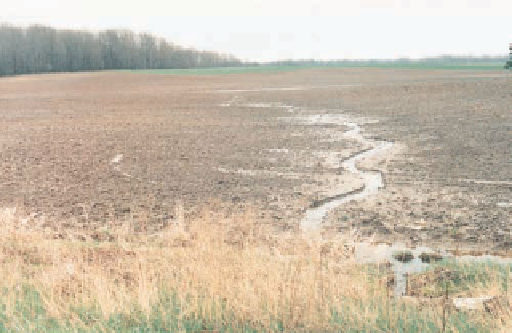Geology Reference
In-Depth Information
How much time is needed to develop a centimeter of
soil or a fully developed soil a meter or so deep? We can give
no definite answer because weathering proceeds at vastly
different rates depending on climate and parent material,
but an overall average might be about 2.5 cm per century.
Nevertheless, a lava fl ow a few centuries old in Hawaii may
have a well-developed soil on it, whereas a fl ow the same age
in Iceland will have considerably less soil. Given the same
climatic conditions, soil develops faster on unconsolidated
sediment than it does on bedrock.
scours small, troughlike channels. Channels shallow enough
to be eliminated by plowing are
rills
, but those too deep
(about 30 cm) to be plowed over are
gullies
(
◗
Figure 6.13).
Where gullying is extensive, croplands can no longer be tilled
and must be abandoned.
Soil undergoes chemical deterioration when its nutri-
ents are depleted and its productivity decreases. Loss of soil
nutrients is most notable in many of the populous develop-
ing nations where soils are overused to maintain high levels
of agricultural productivity. Chemical deterioration is also
caused by insuffi cient use of fertilizers and by clearing soils
of their natural vegetation.
Other types of chemical deterioration are pollution and
salinization
, which occurs when the concentration of salts
increases in a soil, making it unfi t for agriculture. Improper
disposal of domestic and industrial wastes, oil and chemical
spills, and the concentration of insecticides and pesticides
in soils all cause pollution. Soil pollution is a particularly
serious problem in some parts of Eastern Europe.
Soil deteriorates physically when it is compacted by the
weight of heavy machinery and livestock, especially cattle.
Compacted soils are more costly to plow, and plants have a
more diffi cult time emerging from them. Furthermore, water
does not readily infi ltrate, so more runoff occurs; this in turn
accelerates the rate of water erosion.
In North America, the rich prairie soils of the midwest-
ern United States and the Great Plains of the United States
and Canada are suffering soil degradation. Nevertheless, this
degradation is moderate and less serious than in many other
parts of the world. Problems experienced in the past have
stimulated the development of methods to minimize soil
erosion on agricultural lands. Crop rotation, contour plow-
ing (
In the context of geologic time, soils form rapidly; however,
from the human perspective, the processes are so slow that
soil is a nonrenewable resource. So any soil losses that exceed
the rate of soil formation are viewed with alarm. Likewise,
any reduction in soil fertility or production is cause for
concern, especially in areas where soils provide only a mar-
ginal existence. Any process that removes soil or makes it less
productive is defi ned as
soil degradation
, a serious problem
in many parts of the world that includes erosion, chemical
deterioration, and physical changes.
Erosion, an ongoing natural process, is usually slow
enough for soil formation to keep pace, but unfortunately,
some human practices add to the problem. Removing natural
vegetation by plowing, overgrazing, overexploitation for fi re
wood, and deforestation all contribute to erosion by wind and
running water. The Dust Bowl that developed in several Great
Plains states during the 1930s is a poignant example of just
how effective wind erosion is on soil pulverized and exposed
by plowing (see Geo-Focus 6.1 on pages 148 and 149).
Wind has caused considerable soil erosion in some ar-
eas, but running water is much more powerful. Some soil is
removed by
sheet erosion
, which involves the removal of thin
layers of soil more or less evenly over a broad, sloping sur-
face.
Rill erosion
, in contrast, takes place when running water
◗
Figure 6.14), and the construction of terraces have all
proved helpful. So has no-till planting, in which the residue
from the harvested crop is left on the ground to protect the
surface from the ravages of wind and water.
a
Rill erosion in a fi eld in Michigan during a rainstorm. The rill was
later plowed over.
b
A large gully in the upper basin of the Rio Reventado in Costa
Rica. Notice the man at the right for scale.
◗
Figure 6.13
Soil Degradation Resulting from Erosion




Search WWH ::

Custom Search